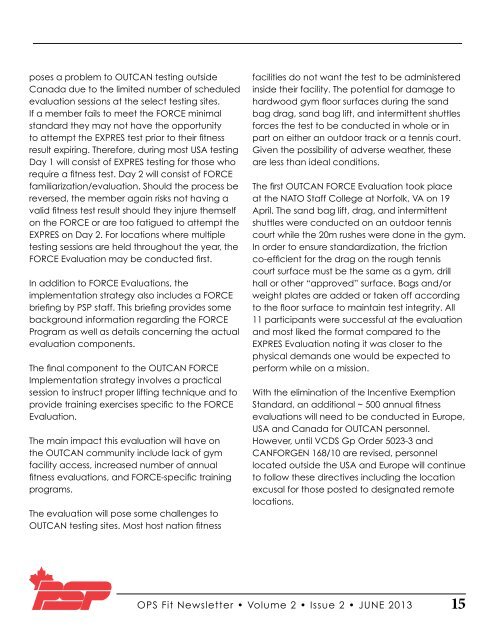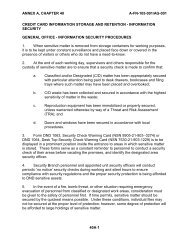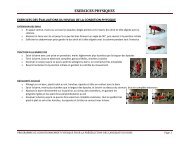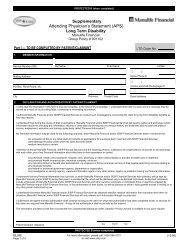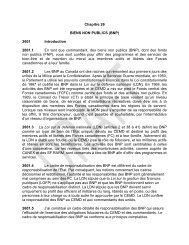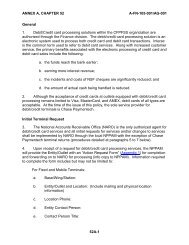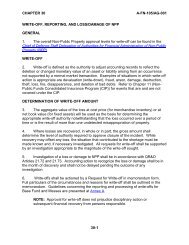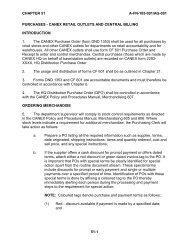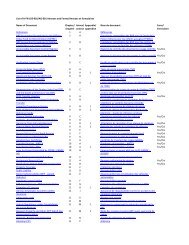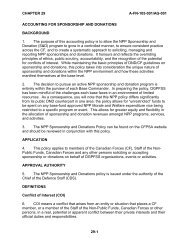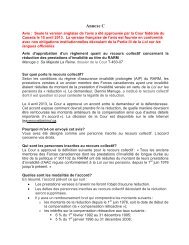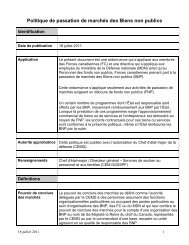June 2013 - Canadian Forces Personnel Support Agency
June 2013 - Canadian Forces Personnel Support Agency
June 2013 - Canadian Forces Personnel Support Agency
Create successful ePaper yourself
Turn your PDF publications into a flip-book with our unique Google optimized e-Paper software.
poses a problem to OUTCAN testing outside<br />
Canada due to the limited number of scheduled<br />
evaluation sessions at the select testing sites.<br />
If a member fails to meet the FORCE minimal<br />
standard they may not have the opportunity<br />
to attempt the EXPRES test prior to their fitness<br />
result expiring. Therefore, during most USA testing<br />
Day 1 will consist of EXPRES testing for those who<br />
require a fitness test. Day 2 will consist of FORCE<br />
familiarization/evaluation. Should the process be<br />
reversed, the member again risks not having a<br />
valid fitness test result should they injure themself<br />
on the FORCE or are too fatigued to attempt the<br />
EXPRES on Day 2. For locations where multiple<br />
testing sessions are held throughout the year, the<br />
FORCE Evaluation may be conducted first.<br />
In addition to FORCE Evaluations, the<br />
implementation strategy also includes a FORCE<br />
briefing by PSP staff. This briefing provides some<br />
background information regarding the FORCE<br />
Program as well as details concerning the actual<br />
evaluation components.<br />
The final component to the OUTCAN FORCE<br />
Implementation strategy involves a practical<br />
session to instruct proper lifting technique and to<br />
provide training exercises specific to the FORCE<br />
Evaluation.<br />
The main impact this evaluation will have on<br />
the OUTCAN community include lack of gym<br />
facility access, increased number of annual<br />
fitness evaluations, and FORCE-specific training<br />
programs.<br />
The evaluation will pose some challenges to<br />
OUTCAN testing sites. Most host nation fitness<br />
facilities do not want the test to be administered<br />
inside their facility. The potential for damage to<br />
hardwood gym floor surfaces during the sand<br />
bag drag, sand bag lift, and intermittent shuttles<br />
forces the test to be conducted in whole or in<br />
part on either an outdoor track or a tennis court.<br />
Given the possibility of adverse weather, these<br />
are less than ideal conditions.<br />
The first OUTCAN FORCE Evaluation took place<br />
at the NATO Staff College at Norfolk, VA on 19<br />
April. The sand bag lift, drag, and intermittent<br />
shuttles were conducted on an outdoor tennis<br />
court while the 20m rushes were done in the gym.<br />
In order to ensure standardization, the friction<br />
co-efficient for the drag on the rough tennis<br />
court surface must be the same as a gym, drill<br />
hall or other “approved” surface. Bags and/or<br />
weight plates are added or taken off according<br />
to the floor surface to maintain test integrity. All<br />
11 participants were successful at the evaluation<br />
and most liked the format compared to the<br />
EXPRES Evaluation noting it was closer to the<br />
physical demands one would be expected to<br />
perform while on a mission.<br />
With the elimination of the Incentive Exemption<br />
Standard, an additional ~ 500 annual fitness<br />
evaluations will need to be conducted in Europe,<br />
USA and Canada for OUTCAN personnel.<br />
However, until VCDS Gp Order 5023-3 and<br />
CANFORGEN 168/10 are revised, personnel<br />
located outside the USA and Europe will continue<br />
to follow these directives including the location<br />
excusal for those posted to designated remote<br />
locations.<br />
OPS Fit Newsletter • Volume 2 • Issue 2 • JUNE <strong>2013</strong> 15


